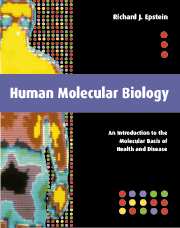Book contents
- Frontmatter
- Contents
- Preface
- Acknowledgements
- Read me first …
- Glossary
- Dedication
- Introduction: A disease for every gene?
- I From molecular biology to human genetics
- 1 Biomolecular evolution
- 2 Chromatin and chromosomes
- 3 Gene expression
- 4 RNA processing and translation
- 5 Protein structure and function
- II From molecular genetics to human biochemistry
- III From molecular biochemistry to human cell biology
- IV From molecular cell biology to human physiology
- V From molecular physiology to human molecular biology
- Index
5 - Protein structure and function
Published online by Cambridge University Press: 01 June 2011
- Frontmatter
- Contents
- Preface
- Acknowledgements
- Read me first …
- Glossary
- Dedication
- Introduction: A disease for every gene?
- I From molecular biology to human genetics
- 1 Biomolecular evolution
- 2 Chromatin and chromosomes
- 3 Gene expression
- 4 RNA processing and translation
- 5 Protein structure and function
- II From molecular genetics to human biochemistry
- III From molecular biochemistry to human cell biology
- IV From molecular cell biology to human physiology
- V From molecular physiology to human molecular biology
- Index
Summary
Proteins yell stage directions at DNA, and DNA reads its genetic script back to protein; in this way the cytoplasm talks to the nucleus and vice versa. This dialogue is well illustrated by cell fusion experiments in which the nucleus of one cell is added to the cytoplasm of another, redirecting the latter cell's behavior. In the following chapter we discuss how proteins direct the life of cells.
Protein structure
Proteins are amino acid polymers
With the exception of a few genes – such as those encoding ribosomal RNA (rRNA) – human genes are transcribed and translated to form proteins. Perhaps as many as three or four different protein forms are produced in the body by each gene, reflecting the diversifying influence of downstream transcript and protein modifications.
Proteins are conglomerations of amino acids, which originate as linear ribbon-like structures synthesized by ribosomes in response to instructions from transfer RNA (tRNA), messenger RNA (mRNA) and DNA. Each ribosome binds two tRNA molecules and approximately 40 base pairs (bp) of mRNA. Since an average amino acid has a molecular weight of ∼120 daltons, a 50-amino-acid polypeptide weighs in at around 6000 daltons (6 kDa). An “average” protein contains about 400 amino acids, corresponding to a molecular weight of around 50 kDa, but the range extends from less than 10 kDa to over 1000 kDa. Up to 20 amino acids per second are incorporated into a growing polypeptide chain, implying that an average protein is synthesized in less than a minute.
- Type
- Chapter
- Information
- Human Molecular BiologyAn Introduction to the Molecular Basis of Health and Disease, pp. 114 - 144Publisher: Cambridge University PressPrint publication year: 2002



